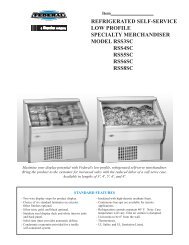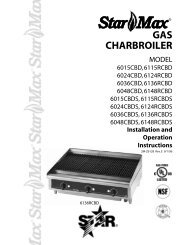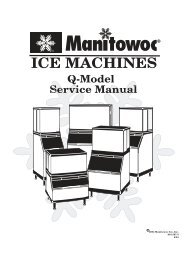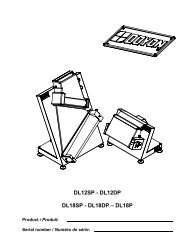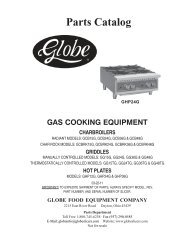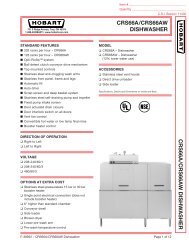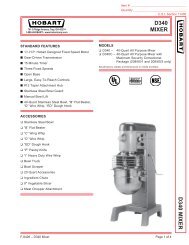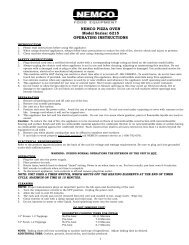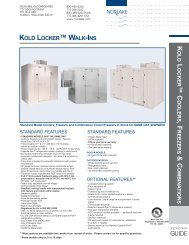DEEP FAT FRYER
DEEP FAT FRYER
DEEP FAT FRYER
- No tags were found...
Create successful ePaper yourself
Turn your PDF publications into a flip-book with our unique Google optimized e-Paper software.
CARE OF <strong>FAT</strong>In three to six months you may spend as much for fatas you paid for your kettle. So fat is an item you wantto know all about; how to select it; how to manage it.The more production you can get from each pound offat, the more profi table your frying operation will be.To get a high rate of production per pound of fat youhave to avoid two things. One is early breakdownand spoilage of the compound so that you have tothrow it away before it does enough work to "earn itskeep." The other is excessive sponging up of fat bythe food being fried.The main cause of fat breakdown is excessive heat.On the other hand abnormal absorption is caused byfrying too long at too low temperatures. One answerto both problems is exact control of heat — so thatfat neither smokes up nor soaks up.Of course, no fat "keeps" forever. Not only heat, butair and moisture, salt particles and crumbs of foodwork to break it down. But you can slow up fat deteriorationby maintaining proper temperatures andby draining your kettle, fi ltering or straining the fatonce or twice a day and by keeping the kettle itselfabsolutely clean.A number of commercial devices and materials areavailable to aid in eliminating fat impurities. There areseveral excellent models of pressure fi lters as wellas strainer-type fi lters, which, if used regularly, willprolong life of fat.However, no purifi cation device will renew brokendown or rancid fat or put new life into it. Once youhave allowed fat to break down it becomes unsuitablefor frying — in fact browning is impossible.In addition to filtration, you can prolong the usefulnessof fat by sweetening it with fresh compound every day- replacing about 15% of the bulk you started with. Ifyou do enough frying so that normal absorption of fatin food amounts to 15% to 20% of the capacity of yourkettle every day - then you can call that your turn-overfood. It means you can add the recommended 15%of fresh fat without discarding any of the old.10 POINT PROGRAMTO PRESERVE <strong>FAT</strong> AND PRODUCE THE FINEST FRIED FOODS1. Choose a fat that does not break down quickly.Hydrogenated shortening, corn, and peanut oilsare less likely to break down under high temperatures.2. Do not fry foods at temperatures above thoserecommended. The higher the fat temperature,the more rapid the rate of fat deterioration. Above400°F fats quickly deteriorate.3. During short intervals between frying, turn theheat down. Do not keep heat on for long periodsbetween batches.4. Keep fat clean. Strain or fi lter daily or at end ofeach shift. Add at least 15% fresh fat to yourkettle daily.6. Discard fat that tends to bubble excessively beforefood is added.7. Do not overload baskets-pieces should not touchwhen frying. Shake baskets to prevent food fromsticking together. Fry similar sizes together.8. Never salt foods directly over fat, salt in fat reducesits life.9. Raw, wet foods, such as potatoes and oysters,should be drained or wiped dry before frying toextend the life of the frying fat. Have foods to befried at room temperature.10. Keep fat temperatures below smoking point tominimize frying odors.5. At least once a day, cool a small amount of fat andtaste it to see if it has picked up foreign fl avors.7




